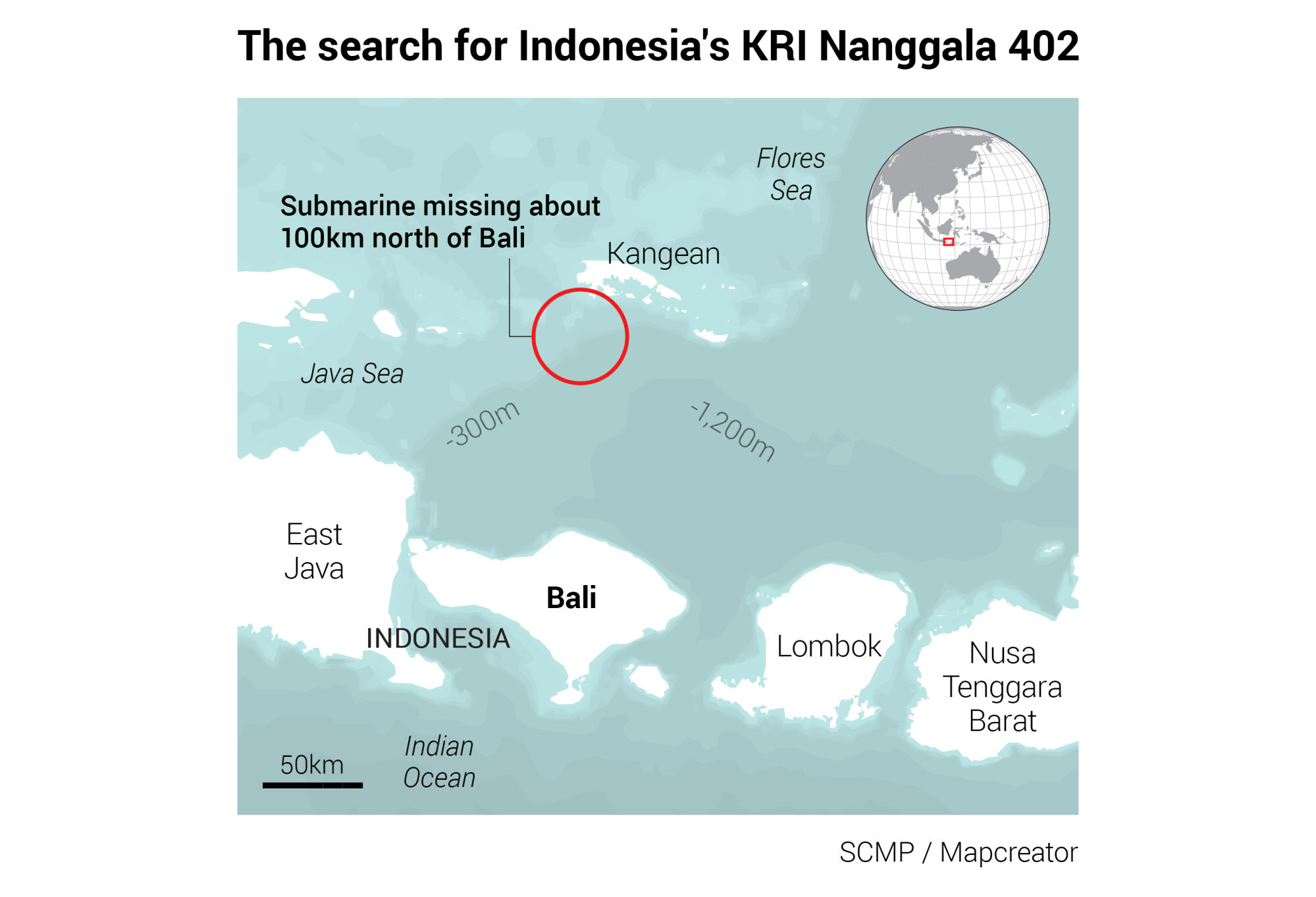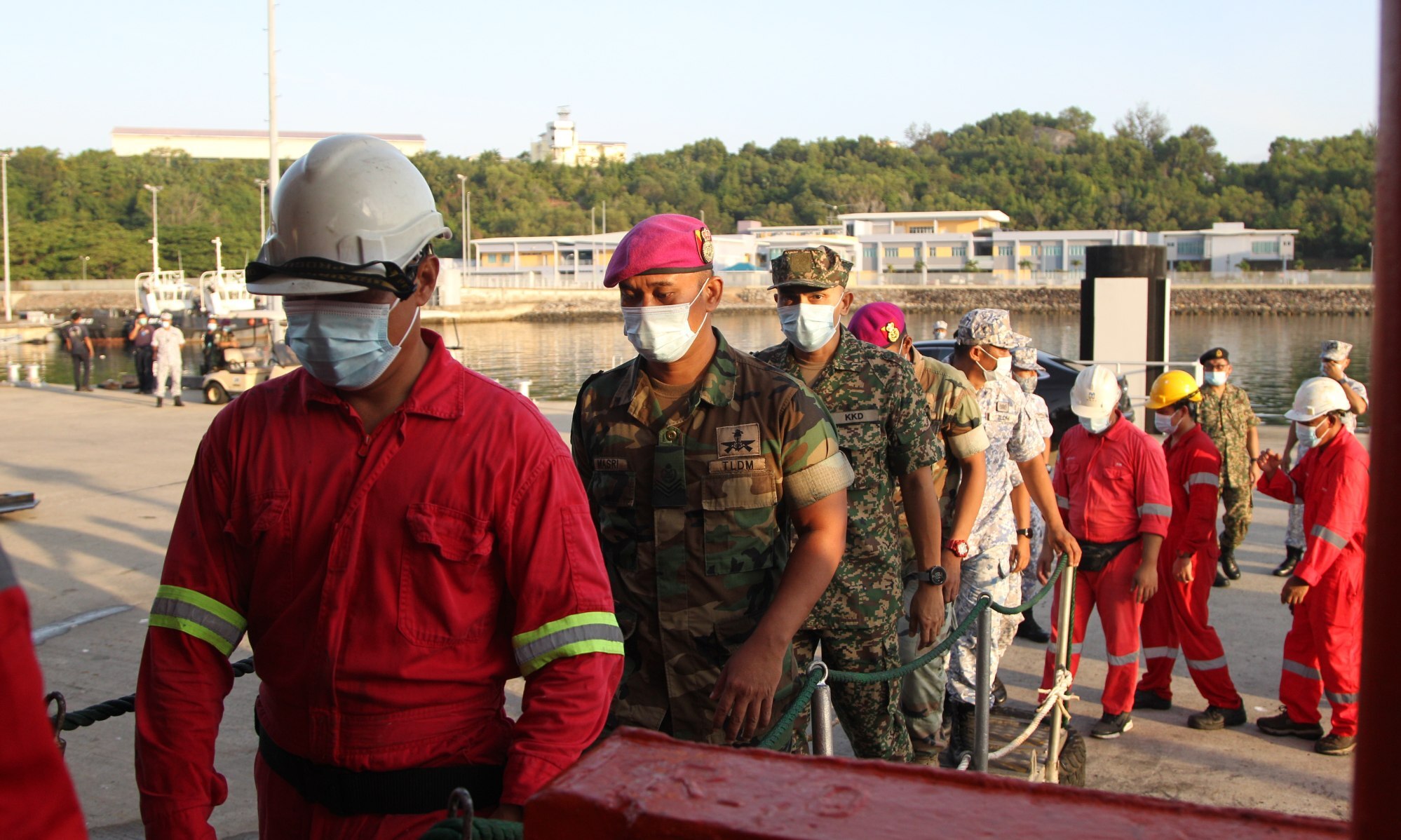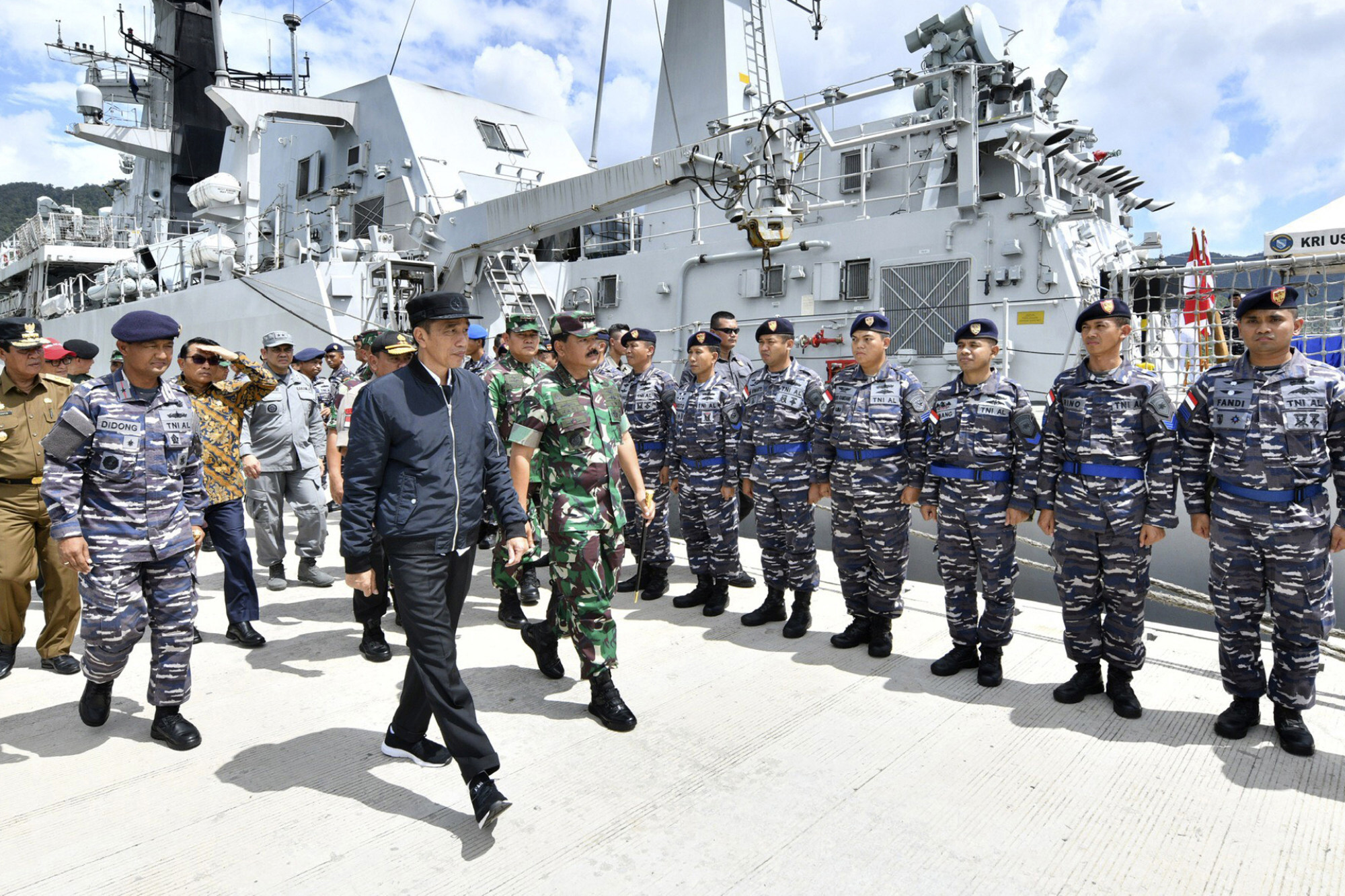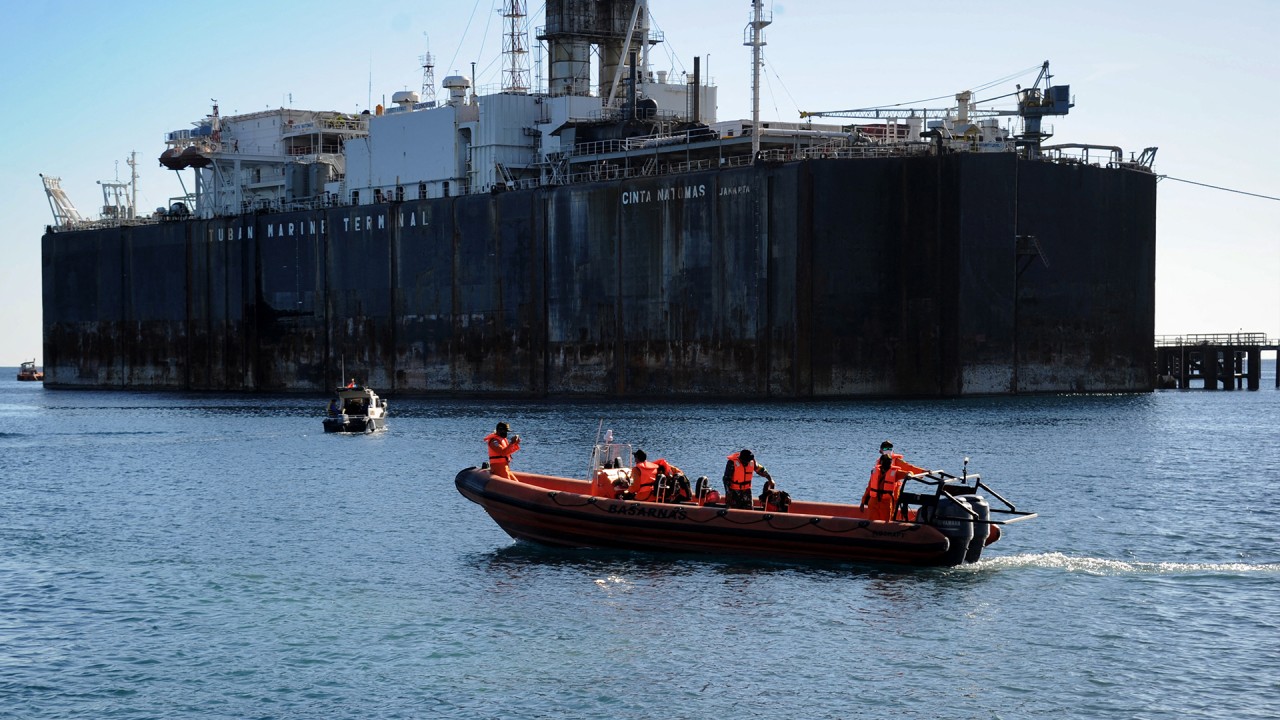
As Indonesia races to find missing submarine, vessel’s age comes under scrutiny
- The 44-year-old submarine fell out of contact early on Wednesday during a training exercise in the waters off Bali
- Analysts said the incident highlights the risks of Indonesia’s ageing military equipment and the chronic underfunding of the navy and air force
Indonesian navy chief Yudo Margono on Thursday said the oxygen would last until about 3am on Saturday, under the current situation of a power “blackout”.

“The oxygen capacity is 72 hours. Hopefully it can be found before that when there is still reserve oxygen,” said Margono said in Bali at a press conference also attended by Defence Minister Prabowo Subianto and Armed Forces commander Hadi Tjahjanto.
Margono added that the diesel-powered submarine had received a letter of feasibility from the navy and was battle-ready.
A security source, who did not want to be named, told This Week in Asia the submarine usually had a crew capacity of 34 but “additional men were placed on board” during the exercise.
Indonesian submarine goes missing off north Bali
Frank Owen, secretary of the Submarine Institute of Australia, said submarines generally had enough emergency oxygen supplies to cope without external support for seven days.
These included chemical candles, which produce oxygen when burned, as well as canisters that extract carbon dioxide when air is sucked through them.
“The issue is that there are reportedly 53 people on board when the regular crew capacity is 34,” Owen said. “That means an extra 55 per cent more people than the emergency system is designed to support.”
Collin Koh, a research fellow at the Institute of Defence and Strategic Studies in Singapore, said the extent of damage of the submarine and the condition of its carbon dioxide scrubbers were other factors that could affect the crew’s oxygen supply.
“If those scrubbers are damaged, it’ll foul up the entire interior of the boat and lead to problems, too,” Koh said, referring to equipment that absorbs carbon dioxide.
“It’s also important to note that unlike a nuclear submarine – which can infinitely generate oxygen for the crew – a diesel-electric powered boat such as Nanggala has a finite supply of oxygen that can only depend on the reserve tanks on board, and the ability to go up to snorting depth to take in fresh air to de-foul the interior, and recharge the batteries.”
Are Indonesia-Japan South China Sea drills a sign of Jakarta’s pivot away from Beijing?
The 1,300-tonne vessel can go to a depth of 250-500 metres (820-1,600 feet) but Indonesian military officials on Wednesday said it was believed to be submerged at a depth of 600-700 metres (2,000-2,300 feet), raising concerns among experts for the fate of the 53 crew members.
“Should the ship have sunk to the seabed, where it was last believed to have been, it far exceeds the depth or pressure for which it was rated,” said Zachary Abuza, professor of Southeast Asia studies at the Washington-based National War College. “That, unfortunately, is a death sentence for the 53 crew.”
Antoine Beaussant, a French navy vice-admiral, said the KRI Nanggala 402 was not built to withstand those depths. “If it went down to rest at 700 metres, the likelihood is it would have broken up,” Beaussant told AFP.

Even the more optimistic scenario would be riddled with challenges.
Owen of the Submarine Institute of Australia said if the KRI Nanggala 402 was at its normal operating depth but had no battery power or its propulsion motor was broken, “it may not be able to surface”.
Indonesian navy spokesman Julius Widjojono told CNN Indonesia it did not have the equipment to lift the submarine from the water and hence made a distress call to the International Submarine Escape and Rescue Liaison Office.
Singapore and Malaysia have dispatched rescue vessels due to arrive on Saturday. The military said Australia, the United States, Germany, France, Russia, India and Turkey had also offered assistance.
The Indonesian military has sent out five warships, a helicopter and 400 workers to search for the missing submarine. Two navy vessels with sonar capability were deployed, officials said.
An aerial search found an oil spill near the submarine’s dive location. Navy chief Margono said authorities had also found an item with “high magnetic force” floating at a depth of 50-100 metres.

AGEING EQUIPMENT
The KRI Nanggala 402, which was made in 1977 and came into service in 1981, is a vintage Cakra-class vessel built by the former West Germany during the Cold War. It has been used by more than a dozen navies over the past five decades, including those from Argentina, Greece, India and Turkey.
Analysts said its age underscored the dangers of Indonesia’s old military equipment.
Koh said the submarine went missing in “no small part [due to] ageing military hardware, though submarine accidents can also be attributed to human factors – errors in operating the boat, or even erroneous maintenance work done on the boat while moored alongside”.

Abuza of the National War College said the missing submarine was last refurbished in 2012.
“Submarines last fewer years in tropical waters due to the warmer water, and Indonesia doesn’t have a great track record of caring for its ships,” he said.
Indonesia has a fleet of five submarines, including three newly built from South Korea. The newest, the KRI Alugoro, was assembled locally with South Korean assistance.
“In all, there are five submarines – with the Cakra boats being fully operational and their crews presumably the most experienced – whereas the three Nagapasa-class boats are in various stages of operationalisation,” Koh said.
Military men helped Indonesia’s democracy. Why not in Myanmar?
The 44-year-old submarine also highlights Indonesia’s difficulties in balancing military upgrades and providing welfare and development in the nation of 270 million people.
In Indonesia’s early post-independence days, it had focused on domestic security and socioeconomic development, hence investment into the major armed forces had been slow, Koh said.
Abuza said that, during former president Susilo Bambang Yudhoyono’s administration from 2004 to 2014, he had tried to reorient the armed forces to external threats.
“But even in two terms, there was a limit to what he could do,” he said.
The armed forces budget soared after Jakarta signed a peace agreement with insurgents in Aceh province in 2005, as money spent on fighting rebels was freed up and went to the long-starved navy and air force, Abuza added.
“But even large budgets don’t go that far, as naval and air force platforms are so expensive,” he said.

Indonesia’s navy and air force – particularly during the 32-year rule of the late dictator General Suharto, who hailed from the army – do not share the same status as the military, leaving the nation effectively “landlocked” in its defence views, despite it being an archipelago with more than 17,000 islands.
“The army remains the most senior service, and it’s only in recent decades that the navy and air force started to receive greater priorities when it comes to funding,” Koh said.
Indonesia’s navy and air force endured a significant portion of ageing and legacy assets, many of them dating back to the Cold War, Koh added.
The unevenness and inconsistencies in maintaining, repairing and overhauling these assets affected the forces’ operational safety and readiness.
Far right vs Islamists: a vicious circle of extremism in Southeast Asia?
“These works do cost money as well. And in the climate of financial austerity, either the routine maintenance, repairs and overhaul schedules are overlooked, or the personnel themselves don’t get to go out on their assets to carry out training to keep up with their proficiency in operating the equipment,” Koh said.
Abuza said the situation had deteriorated under the Widodo administration.
“Not only is the TNI [Indonesian Armed Forces] landlocked in its view of security, it’s actually gotten worse since President Joko Widodo was elected in 2014,” he said.

“His [previous] defence minister, Ryamizard Ryacudu, a ‘New Order’ dinosaur, implemented his policy Bela Negara, which reoriented the TNI to internal threats, including insurgency, narcotics and anti-communism,” Abuza said, referring to the era ruled by Suharto.
“Despite Jokowi’s very well thought out Maritime Fulcrum strategy, he never implemented it, and instead caved in to the TNI’s budgetary and policy priorities. It was a failure of leadership. To this day, the TNI is still seeking barter deals with Russia to expand their air force.”
Indonesia arms maritime force to deter Chinese, Vietnamese fishing vessels from entering Natunas
Indonesian Defence Minister Prabowo Subianto, a former three-star general, on Thursday acknowledged the country’s challenges of balancing welfare and economic reform with military investment.
“The primary weapons system for defence I would say is very expensive and because of that, the country’s leadership is faced with the dilemma of prioritising social welfare development,” Prabowo said. “But at the same time, [it is important to] ensure the defence capacity to safeguard our sovereignty so that it won’t be encroached upon.”
Prabowo also said he would soon present a 25-year master plan for the country’s defence to Widodo. The plan, which he drafted together with armed forces chief Tjahjanto, has been almost a year in the making.


